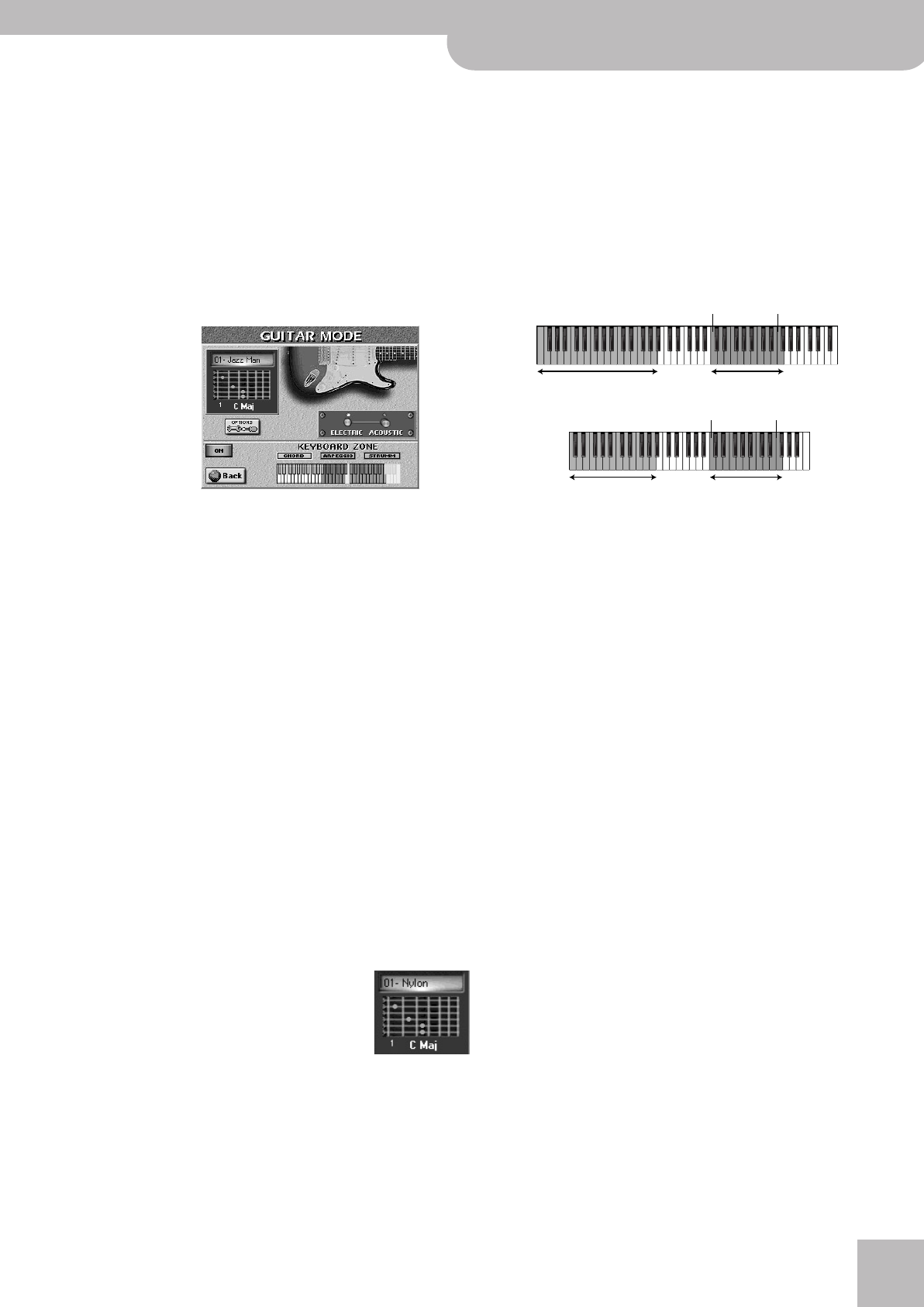
Playing realistic guitar parts (Guitar mode)
E-60/E-50 Music Workstation
r
31
Selecting guitar sounds
Now that you know how to use some of the Guitar
functions, let’s try these techniques with different
sounds. Additional playing techniques are discussed
under “Using the available STRUMM techniques” on
p. 31.
(1) Press the EASY SETTING [GUITAR] button.
Note: You can also select this page by pressing [MENU] button
‰ [GUITAR¥MODE]. In that case, you may need to switch the
Guitar mode on using the [Off/On] switch icon (see below).
The indicators of this button lights and the display
changes to:
The [Off÷On] switch icon allows you switch the Guitar
mode on or off. If you selected this page by pressing
EASY SETTING [GUITAR], it is already set to on.
(2) Press the [ELECTRIC] or [ACOUSTIC] switch icon to
specify whether you need an electric or an acoustic
guitar.
This is an important choice to make, because it deter-
mines which guitar sounds can be selected (electric
or acoustic ones).
(3) Select the desired sound (see the upper left corner)
with the [DATA÷ENTRY] dial or the [DEC]/[INC] but-
tons.
The possibilities are:
About the chord indications
The GUITAR MODE page contains a
“window” that shows you how the
chords you play on the keyboard are
transformed into guitar chords. The
small numbers refer to the lowest fret
being used. An “x” means that the string in question
doesn’t sound (guitarists sometimes use ony four or
three strings for their chords). And finally: the strings
are shown from high E (top) to low E (bottom) – that’s
how guitar tablatures are usually printed. The guitar
neck has therefore been turned upside down.
Using the available STRUMM techniques
While the “ARPEGGIO” area essentially provides func-
tions that allow you to “compose” your own guitar
parts in realtime, the “STRUMM” area contains a series
of presets for various strumming techniques. “Strum-
ming”, as you may know, means that all guitar strings
are played more or less simultaneously using a plec-
trum or one’s fingers.
All functions discussed below use the chords you spec-
ify in the “CHORD” area (see above). Here are the keys
that make up the “STRUMM” section:
Note: As stated earlier, UP1 and UP2 are not available in Guitar
mode, because they are used as guitar parts.
Note: The E-60/E-50’s Arranger can also be used and controlled
while Guitar mode is active, so that the chords you play with your
left hand are used both by the E-60/E-50’s Arranger and its Gui-
tar mode functionality.
(1) Select the required guitar type (ELECTRIC or
ACOUSTIC) and the desired sound.
See “Selecting guitar sounds”.
(2) Play a chord in the keyboard area called “CHORD”
in the display.
(3) Press one of the following keys to specify how your
virtual guitar should be played.
The lowest “STRUMM” key is called “C5”, the black key
next to it “C#5”, etc.
Some of the keys mentioned below produce two
effects: one when you press (“e”) them, another
when you release (“a”) them. Entries without those
symbols are ‘’one-way” and therefore only trigger an
effect when you press them.
● Down fast (C5)—This key causes all six strings to sound
at the same time. This is the fast version of the strum-
ming pattern mentioned earlier. (The slow version can
also be played using the F#5 key.)
● e Down fast/a up fast (C#5)—Pressing this key trig-
gers a fast downward strum. “Down” means that the
simulated plectrum (or thumb/finger) moves from the
lowest to the highest string (i.e. towards the lower part
of the guitar). Releasing this key will trigger an upward
strum (in the opposite direction).
● Up fast (D5)—This key causes all six strings to sound at
the same time, this time from the highest to the lowest
string.
ELECTRIC
01: Jazz Man
02: OpenHard 1
03: Dist FX
04: OpenHard 2
05: Overd FX
06: Strat Clean
07: CleanHalf
08: Distorsion
09: Warm Drv
10: Power
11: Dist Guitar
ACOUSTIC
01: Nylon
02: Steel 2
03: Steel 3
04: Steel 4
05: Steel 5
06: 12 guitars
07: Nyl + Steel
08: Nyl + Steel 2
Play chords here Select strumming patterns
here
C5 F6
Play chords here Select strumming patterns
here
C5 F6
E-60
E-50
E-60_50_OM_UK.book Page 31 Thursday, June 22, 2006 10:06 AM
